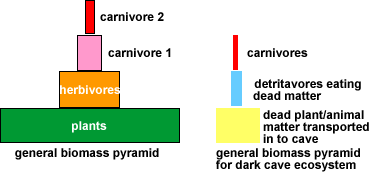5b. Ecology: Food pyramids and biomass
With the absence of plants, most organisms are either detritivores or carnivores. This limited productivity means that the total biomass of organisms is low and cave organisms are never numerous. Dark caves have two distinct but linked communities. The roof community may have bats and the parasites which feed on them. This community relies on journeys to the surface for feeding.
The cave floor community is more complex but relies upon the roof community for much of its food. The organic layer on the floor is composed of the waste products and corpses of animals from the roof as well as the floor. Woodlice, flies and beetles may feed on the guano of bats. The carnivores then feed on the guano eaters. These include spiders and centipedes.
| Plant Biomass (world average from Krebs 1978) | |
| tropical rainforest 45 kg/m2 | alpine 0.6 kg/m2 |
| woodland 6 kg/m2 | dark cave 0.002 kg/m2 |
 The
biomass pyramids compare a traditional pyramid to that found in dark caves.
These diagrams are generalisations. Each cave has it's own pyramid, however,
if drawn to scale the cave biomass pyramid would be over
The
biomass pyramids compare a traditional pyramid to that found in dark caves.
These diagrams are generalisations. Each cave has it's own pyramid, however,
if drawn to scale the cave biomass pyramid would be over 20 000 times smaller than one for a rainforest. In deep caves there is little to no light, so the food chain has no direct source of energy.
| adaptations |